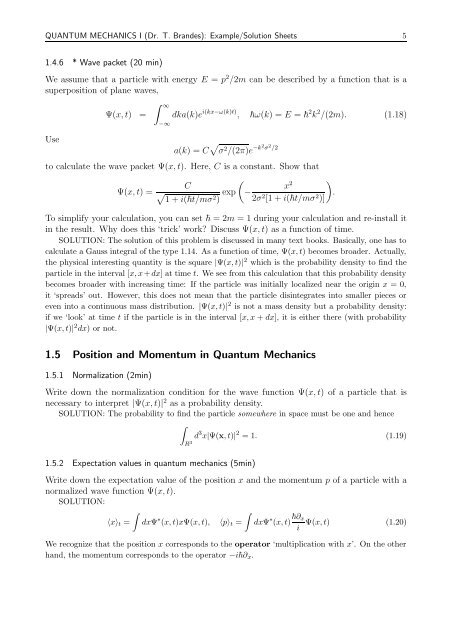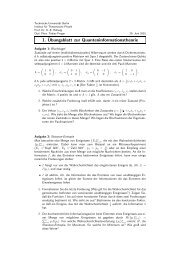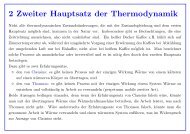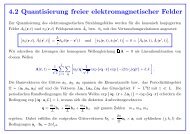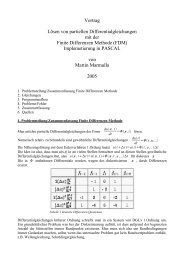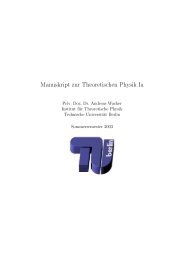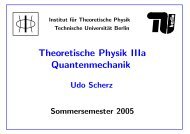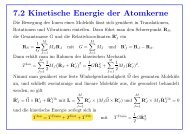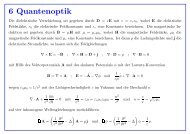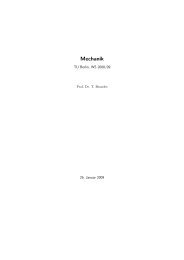1.1 The Radiation Laws and the Birth of Quantum Mechanics
1.1 The Radiation Laws and the Birth of Quantum Mechanics
1.1 The Radiation Laws and the Birth of Quantum Mechanics
Create successful ePaper yourself
Turn your PDF publications into a flip-book with our unique Google optimized e-Paper software.
QUANTUM MECHANICS I (Dr. T. Br<strong>and</strong>es): Example/Solution Sheets 5<br />
1.4.6 * Wave packet (20 min)<br />
We assume that a particle with energy E = p 2 /2m can be described by a function that is a<br />
superposition <strong>of</strong> plane waves,<br />
Ψ(x, t) =<br />
∫ ∞<br />
−∞<br />
dka(k)e i(kx−ω(k)t) , ω(k) = E = 2 k 2 /(2m). (<strong>1.1</strong>8)<br />
Use<br />
a(k) = C √ σ 2 /(2π)e −k2 σ 2 /2<br />
to calculate <strong>the</strong> wave packet Ψ(x, t). Here, C is a constant. Show that<br />
)<br />
C<br />
Ψ(x, t) = √<br />
(−<br />
1 + i(t/mσ2 ) exp x 2<br />
.<br />
2σ 2 [1 + i(t/mσ 2 )]<br />
To simplify your calculation, you can set = 2m = 1 during your calculation <strong>and</strong> re-install it<br />
in <strong>the</strong> result. Why does this ‘trick’ work Discuss Ψ(x, t) as a function <strong>of</strong> time.<br />
SOLUTION: <strong>The</strong> solution <strong>of</strong> this problem is discussed in many text books. Basically, one has to<br />
calculate a Gauss integral <strong>of</strong> <strong>the</strong> type <strong>1.1</strong>4. As a function <strong>of</strong> time, Ψ(x, t) becomes broader. Actually,<br />
<strong>the</strong> physical interesting quantity is <strong>the</strong> square |Ψ(x, t)| 2 which is <strong>the</strong> probability density to find <strong>the</strong><br />
particle in <strong>the</strong> interval [x, x + dx] at time t. We see from this calculation that this probability density<br />
becomes broader with increasing time: If <strong>the</strong> particle was initially localized near <strong>the</strong> origin x = 0,<br />
it ‘spreads’ out. However, this does not mean that <strong>the</strong> particle disintegrates into smaller pieces or<br />
even into a continuous mass distribution. |Ψ(x, t)| 2 is not a mass density but a probability density:<br />
if we ‘look’ at time t if <strong>the</strong> particle is in <strong>the</strong> interval [x, x + dx], it is ei<strong>the</strong>r <strong>the</strong>re (with probability<br />
|Ψ(x, t)| 2 dx) or not.<br />
1.5 Position <strong>and</strong> Momentum in <strong>Quantum</strong> <strong>Mechanics</strong><br />
1.5.1 Normalization (2min)<br />
Write down <strong>the</strong> normalization condition for <strong>the</strong> wave function Ψ(x, t) <strong>of</strong> a particle that is<br />
necessary to interpret |Ψ(x, t)| 2 as a probability density.<br />
SOLUTION: <strong>The</strong> probability to find <strong>the</strong> particle somewhere in space must be one <strong>and</strong> hence<br />
∫<br />
R 3 d 3 x|Ψ(x, t)| 2 = 1. (<strong>1.1</strong>9)<br />
1.5.2 Expectation values in quantum mechanics (5min)<br />
Write down <strong>the</strong> expectation value <strong>of</strong> <strong>the</strong> position x <strong>and</strong> <strong>the</strong> momentum p <strong>of</strong> a particle with a<br />
normalized wave function Ψ(x, t).<br />
SOLUTION:<br />
∫<br />
〈x〉 t =<br />
∫<br />
dxΨ ∗ (x, t)xΨ(x, t), 〈p〉 t =<br />
dxΨ ∗ (x, t) ∂ x<br />
Ψ(x, t) (1.20)<br />
i<br />
We recognize that <strong>the</strong> position x corresponds to <strong>the</strong> operator ‘multiplication with x’. On <strong>the</strong> o<strong>the</strong>r<br />
h<strong>and</strong>, <strong>the</strong> momentum corresponds to <strong>the</strong> operator −i∂ x .


